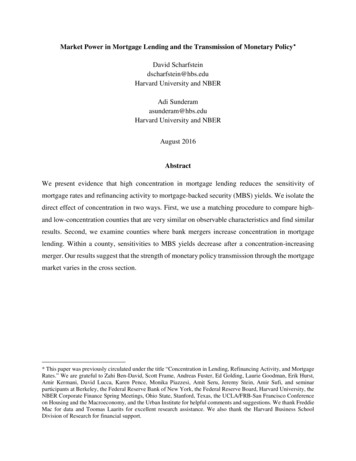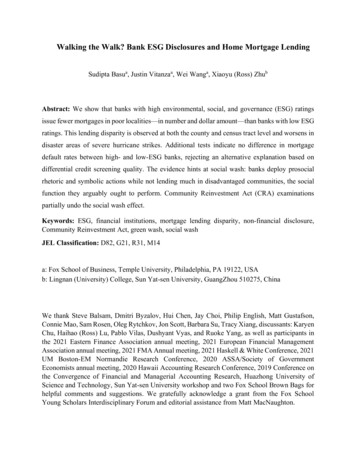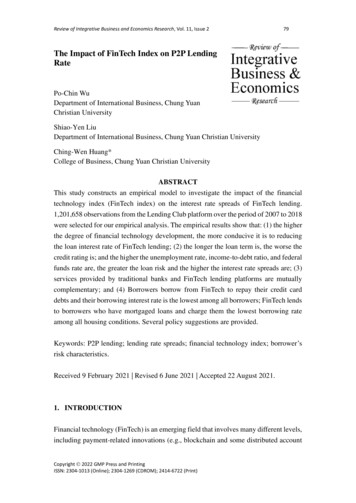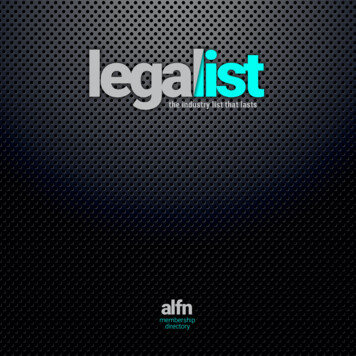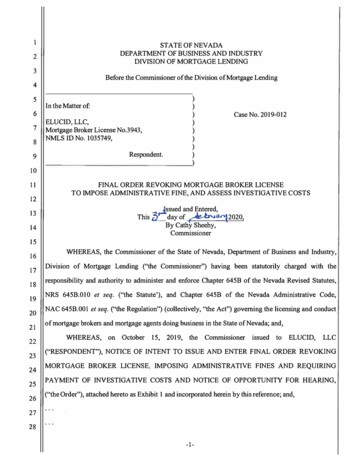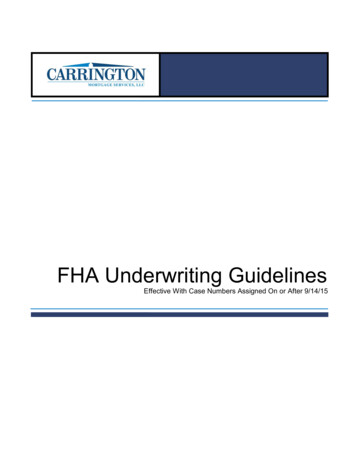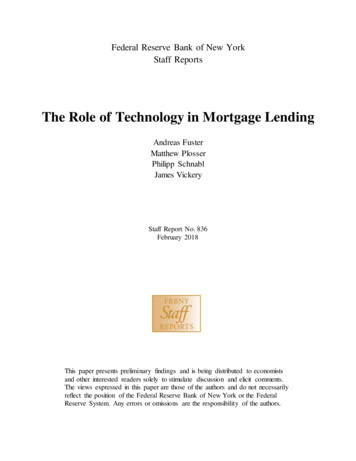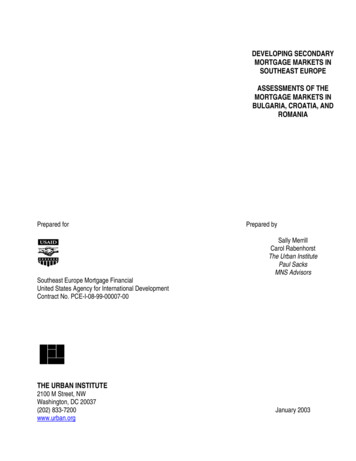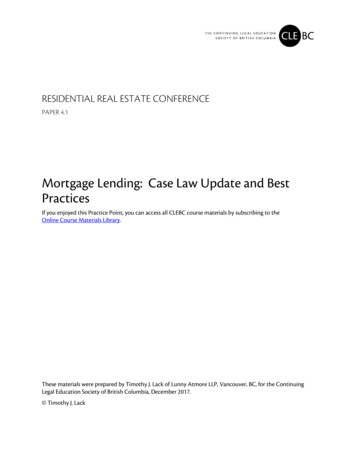
Transcription
RESIDENTIAL REAL ESTATE CONFERENCEPAPER 4.1Mortgage Lending: Case Law Update and BestPracticesIf you enjoyed this Practice Point, you can access all CLEBC course materials by subscribing to theOnline Course Materials Library.These materials were prepared by Timothy J. Lack of Lunny Atmore LLP, Vancouver, BC, for the ContinuingLegal Education Society of British Columbia, December 2017. Timothy J. Lack
4.1.1MORTGAGE LENDING: CASE LAW UPDATE AND BESTPRACTICESI.Update on Recent Case Law . 1II.Best Practices in Your Mortgage Practice . 2A. Yes, the Form B Rules the Day, But . 2B. Guarantees and Covenants to Pay . 2C. Interest Act (Canada), Criminal Code, Unconscionable Mortgages . 4D. The Property Law Act and the Section 28 Notice. 6E. GST and Priority Concerns . 6III.Appendix 1 . 8I.Update on Recent Case LawBefore jumping into the meaty issues of mortgage lending, I have taken this opportunity to seek outrecent cases looking at various aspects of mortgage lending and thought it wise to bring you therecent interesting and relevant ones.Summerland & District Credit Union. V. Titan Pacific Contracting Inc., 2016 BCSC 2504This is an interesting case coming out of Penticton, and it deals with those pretty muchstandardized “All Obligations” mortgages. More specifically, it was a mortgage that was meant (bythe lender) to secure all the obligations of the mortgagor and in this case they wanted to secure fourdifferent loans. Most of us should be familiar with the standard language that the lender is relyingon here but please note the mortgage terms from the case:”Obligations” means, at any particular time:(a) all Debts and Liabilities that the Mortgagor has beforethe particular time, acknowledged in writing to, oragreed in writing with, the Credit Union are to besecured by this Mortgage, and(b) all Debts and Liabilities that the Credit Union in its soleand absolute discretion, has by notice in writing to theMortgagor before the particular time, elected to add tothe Obligations and secured by this Mortgage.The issue examined was whether a third and fourth loan came within the above definition ofobligations as the borrowers asserted that there was no written acknowledgement by the borrowersor agreement in writing that those third and fourth loans were to secured by the mortgage, and thatthere was no written notice by the credit union that the loans were to be added to the obligations tobe secured by the mortgage.The judge in this case focused on the above definition, and the requirements set out therein.Further, he looked at the evidence presented as to whether the documentation for the two last loansfit the definition. Accordingly, the Court found that there was simply no evidence that made thetwo last loans subject to the terms of the mortgage. These loans were noted to be loan agreements,just not secured by the mortgage.
4.1.2PRACTICAL TAKE AWAY: When a lender client has an existing “all-indebtedness” stylemortgage security, be sure that future loans are captured by this security in accordance withthe loan terms and the mortgage terms. Get it in writing and give lots of notice, and don’t belazy in relying on the lender’s standard documents.Bankers Mortgage Corporation V. Plaza 500 Hotels Ltd., 2017 BCCA 66This is a case where the borrowers and covenantors defaulted on a mortgage and were held liablefor an “Exit Fee” payable to the mortgage broker under the terms of Loan Retainer Agreement.The borrowers argued that this fee was a penalty on arrears, which we all know, is prohibited underSection 8 of the Interest Act.The trial judge found this fee not to be a penalty, but, rather, a genuine pre-estimate of damages.The Court of Appeal agreed. They stated that the Exit Fee was an unsecured obligation that doesnot prevent the mortgagor from redeeming the property. It is not “stipulated for, taken, reserved orexacted on any arrears of principal or interest secured by mortgage on real property” nor does ithave “the effect of increasing the charge on the arrears beyond the rate payable on principalmoney not in arrears.” Accordingly, and in light of purpose of Section 8, the section did notoperate to prohibit the Exit Fee.PRACTICAL TAKE AWAY: Your mortgage broker and the lender will have, on occasion,competing interests. One is trying to recover a fee, while the other is trying to recover loanedfunds. The case tells us these can be separate issues. As an aside, in the above case, the lenderswere paid out and the mortgage was discharged and the issue before the courts was just theExit Fee.II.A.Best Practices in Your Mortgage PracticeYes, the Form B Rules the Day, But Be mindful, that an agreement that certain property is to stand charged as security for a specifiedsum, if expressed in clear language, may also constitute a mortgage. Also, a formal defect in adocument may still give the right to call for a legal mortgage.PRACTICAL TAKE AWAY: While it seems like the LTO loves to find defects (sorry for thejab), lets always be mindful of the documents that are not drafted as a Form B, but may stillgive your lender client mortgage security (ie. a Promissory Note that includes language thatcreates mortgage security).B.Guarantees and Covenants to PayI appreciate that this will be a mini recap of a topic I touched in previous years, but I continue tosee, with frequency, documents from law firms where the term guarantor and covenantor were usedinter-changeably, and incorrectly, in the various documents. I venture that this error interminology seems to occur in private lending transactions more frequently because of theunsophistication of the instructing lender/broker and that the documents are not those mandatedand prepared by a large financial institution.In the section of the ‘Documentation’ chapter of the Mortgages Practice Manual entitled‘Gathering Information’, one of the matters that must be considered by the lawyer is ‘TheGuarantor/Covenantor’. That section states:
4.1.3“The lender may require persons other than the registered owner of the property to be liable forrepayment of the mortgage loan and observance of the mortgage obligations. These persons aredescribed as guarantors or covenantors. While these terms are sometimes used interchangeably,there is a legal distinction between a guarantee, which creates only an obligation as a surety, and adirect covenant or indemnity. A direct covenant or indemnity is usually required by the lender. ”A lawyer should seek information determining the requirement of covenantors/guarantors in amortgage transaction and seek to determine in what capacity a person is to be liable for repaymentof the mortgage and observance of the mortgage obligations. Where instructions request a personto sign as a guarantor, a lawyer ought to clarify those instructions to ensure that (as I referencedabove) the terms have not been used interchangeably by the lender giving the instructions.All of which information gathering and retainer confirmations are performed and done with theintent that solicitor is assisting the client in avoiding foreseeable risk in the mortgage transaction.At this time, and for good order, the distinction between a covenantor and a guarantor should be setout in order that the reader is aware that there is a distinction and the importance thereto.A covenantor is, in the Prescribed Standard Mortgage Terms, expressed to be “ a primary debtorto the same extent as if the covenantor had signed this mortgage as a borrower and is not merely aguarantor or a surety, ”.On the other hand, a guarantor is that person that enters into a collateral contract called a guaranteeand the guarantor “ undertakes to answer for the debt or the obligation of the principal debtor tothe creditor. In other words, the guarantor promises to the creditor that “if the debtor does notpay, he [or she] will.” (from Bennett in “Creditors’ and Debtors’ Rights and Remedies”)The distinction between a contract of indemnity and a contract of guarantee is simple in principle:(i) in a contract of indemnity, the obligation is an independent undertaking to make good a loss.The indemnitor assumes the primary liability, either alone or concurrently with the principaldebtor; and (ii) in a contract of guarantee, the guarantor assumes a secondary liability to answer forthe principal debtor who remains primarily liable. If the true meaning of the contract is that thepromisor will pay only if a third party does not, then the agreement is a guarantee. If the promisoris liable to pay in any event, then the contract is an indemnity” (see Credit Foncier Trust Companyv. Zatala Holdings Inc., ( 1986), 4 B.C.L.R. 25 (C.A.).The collateral nature of a guarantee distinguishes it from other forms of contract which are oftenemployed to serve similar goals. The simple guarantee is predicated on the principle that the debtorshall first be liable and that once the liability has been established, the guarantor then becomes liablealong with the debtor for the guaranteed obligation. Many guarantees, however, make theguarantor directly liable with the debtor. Therefore, the term “guarantee” may be a misnomer, asthe person who signs the document may in effect be signing a direct contract to pay the creditorirrespective of whether the debtor can pay. This is especially so with bank guarantees. (again, pleasesee Bennett)Please note that with the use of specific language, either by the lender or the lender’s solicitor, aguarantor can be effectively elevated to being a primary obligant directly liable with the debtor.The Mortgages Practice Manual makes this clear:7. GUARANTEE/CONVENANT [§5.25]Many institutional leaders have included guarantor or covenantor provisions intheir filed standard mortgage terms. A covenantor provision is included as section15 of the prescribed standard mortgage terms. The Land Title Transfer FormsGuidebook states that a covenantor or guarantor may sign the Form B Mortgage in
4.1.4Item 12. The covenantor’s or guarantor’s name is to be typed or printed below thesignature. It should also be indicated in Item 12 that the person is signing as“guarantor” or “covenantor”, using the appropriate defined term from the filedstandard mortgage terms. Note that the filed standard mortgage terms mustinclude a guarantor or covenantor provision for this procedure to be followed.Ensure that the reference to the parties reflects the definition of the parties in theapplication mortgage terms (filed or otherwise); see Kalsiv. Achary, 2012 BCSC361.A separate guarantee and covenantor’s agreement that refers to the mortgage mayalso be used to obtain the required covenant or guarantee.Accordingly, lawyers should clarify in what capacity certain persons, are to be liable for therepayment of the mortgage loan and for the observance of the mortgage obligations.In the case of a covenantor, the language necessary in bringing such person into the role as aprimary debtor is found in the Prescribed Standard Mortgage Terms. A solicitor has the necessarylanguage to bind the covenantor readily available without having to produce his or her own termsor receiving them from the lender client.In the case of a guarantor, the main requirement is that [the guarantee] be set out in writing in orderto be enforceable. Further, “[i]n establishing the validity and construing guarantees, many of thebasic rules that developed in the construction and interpretation of contracts are applicable.” (fromBennett) Simply put and for practical purposes, the terms of the guarantee need to be established,in writing. Therefore, be sure to seek instructions from the lender in order to produce theguarantee, or otherwise have the lender’s form of guarantee signed by the guarantor.PRACTICAL TAKE AWAY: Watch your instructions. Be careful not to “willy-nilly”interchange the terms covenantor and guarantor in your documentation. The PrescribedStandard Mortgage Terms uses the term covenantor and sets out such a person’s obligationstherein. It doesn’t use the word the word guarantor so be careful not to reference a guarantorunless you have specific guarantee language in your documents. Also, watch your staff on thisissue as they too may use the terms interchangeably (and wrongly).C.Interest Act (Canada), Criminal Code, Unconscionable MortgagesUnder Section 6 of the Interest Act, when mortgage money is payable in “blended” payments ofprincipal and interest are made, no interest is payable unless the mortgage contains a statement ofthe amount of principal money and the rate of interest chargeable on that money, calculated yearly,or half-yearly, not in advancePRACTICAL TAKE AWAY: Watch your instructions and your documents. Private lenderslove monthly compounding and they also love “prime plus” rates or maybe a combination of afixed and prime plus. A table of equivalent rates should be inserted in the schedule.Sections 2 and 8 of the Interest Act, which read as follows:2. Except as otherwise provided by this Act or any other Act of Parliament, anyperson may stipulate for, allow and exact, on any contract or agreement whatever,any rate of interest or discount that is agreed on.8. (1) No fine, penalty or rate of interest shall be stipulated for, taken, reserved orexacted on any arrears of principal or interest secured by mortgage on realproperty or hypothec on immovables that has the effect of increasing the chargeon the arrears beyond the rate of interest payable on principal money not inarrears.
4.1.5(2) Nothing in this section has the effect of prohibiting a contract for the paymentof interest on arrears of interest or principal at any rate not greater than the ratepayable on principal money not in arrears.In a recent Supreme Court of Canada decision (Krayzel Corp. v. Equitable Trust Co., 2016 SCC18), the majority held that:Section 8 of the Act identifies three classes of charges – a fine, a penalty or a rate ofinterest – that shall not be stipulated for, taken, reserved or exacted, in a mortgageagreement, if the effect of doing so imposes a higher charge on arrears than thatimposed on principal money not in arrears. Section 2 of the Act preserves a generalright of freedom to contract for any rate of interest or discount, with the caveatthat such freedom is subject to what is otherwise provided for by this Act.The ordinary sense of the words that Parliament chose to include in s. 8, readtogether with s. 2 and considered in light of the Act’s objects, support theconclusion that s. 8 applies both to discount (incentives for performance) as well aspenalties for non-performance whenever their effect is to increase the charge onthe arrears beyond the rate of interest payable on principal money not in arrears.By directing the inquiry to the effect of the impugned mortgage term, Parliamentclearly intended that mortgage terms guised as a “bonus”, “discount” or “benefit”would not as such comply with s. 8. Substance, not form, is to prevail. Whatcounts is how the impugned term operates, and the consequences it produces,irrespective of the label used. If its effect is to impose a higher rate on arrears thanon money not in arrears, then s. 8 is offended.And:The labeling of one charge as an “interest rate” and the other as a “pay rate” is ofno consequence, given s. 8’s explicit concern for substance over form.This case is particularly important to note because our British Columbia Court of Appeal hadpreviously concluded that a similar style discount did not offend s.8. (See North West LifeAssurance Co. of Canada v. Kings Mount Holdings Ltd. (1987), 15 B.C.L.R. (2d) 376.PRACTICAL TAKE AWAY: Be aware! Business as usual in BC with respect to discountsfrom high rates that disappear upon a default offends the INTEREST ACT, as our SCC holdsfirm on the concept of substance over form. Section 8 applies both to discounts (incentives forperformance) as well as penalties for non-performance whenever their effect is to increase thecharge on the arrears beyond the rate of interest payable on principal money not in arrears.Also, use language that reverts back to the lower original rate to avoid having the court saythat there is NO interest rate.Section 347 defines a “criminal rate” of interest as an effective annual rate of interest that exceeds60% on credit advanced under an agreement or arrangement. “Interest” is broadly defined as mayinclude application fees, standby fees, broker fees, legal fees and disbursements and other nonrefundable charges. The big concern is that these fees do add up and the rate might be over 60%,which would allow the courts to sever the interest provisions from the mortgage.PRACTICAL TAKE AWAY: Consider including a severance clause stipulating that if anyprovision of the mortgage is found to unenforceable (for example, the rate of interest), thebalance of the mortgage terms will still be operative and binding on the borrowers.Courts can and will exercise their equitable powers to relieve against unconscionable transactions.Please take note that section 9(2) of the Business Practices and Consumer Protection Act, S.B.C.2004, c. 2 provides that where it is alleged that a mortgage transaction is unconscionable, the burdenof proof that the transaction was not unconscionable is ON THE LENDER. Section 8 of the same
4.1.6Act obliges a court to consider all the surrounding circumstances of a mortgage transaction that thelender knew or ought to have known – in particular:(1)whether the lender subjected the borrower or guarantor to undue pressure to enterinto the transaction;(2)whether the lender took advantage of the borrower or guarantor’s inability orincapacity to reasonably protect his or her own interest because of the borrower orguarantor’s physical or mental infirmity, ignorance, illiteracy, age, or inability tounderstand the transaction;(3)whether at the time the transaction was entered into, the cost of the transactiongrossly exceeded the cost to like borrowers;(4)whether at the time the transaction was entered into, there was no reasonableprobability of repayment;(5)whether the terms were so harsh or adverse to the borrower as to be inequitable.PRACTICAL TAKE AWAY: Record (in writing) the facts where the mortgage transactionthat was instructed to you has harsher than usual terms or higher than usual interest rates orfees. In that case, you would be best to send the borrower out for independent legal advice andyou should also warn your lender client that the transaction may later be set aside or varied.Note, you may not be privy to all the surrounding circumstances even if your client is so aware.D.The Property Law Act and the Section 28 NoticeWhen doing a second mortgage (that is often an equity take out mortgage) ensuring that the secondmortgage isn’t squeezed out of recovery as against the property on account of a prior mortgagetaking all of the equity out of the property is of fundamental importance. It sounds easy enough toconfirm the first and send a “section 28 notice letter”, but there are no ready or standard precedentsfor this task. Although I do think the Act sets out the minimum of what needs to done sufficientlyclear, I urge you to grab some of the past CLE’s on this subject, and get up to speed on the correctmanner in confirming the first and giving notice to that prior mortgagee after your second isregistered. But, for good order and because people do call me on this matter I will leave you with apractical take away.PRACTICAL TAKE AWAY: Seek the first mortgage balance yourself and directly from theprior mortgagee. Send your Section 28 notice letter, even if the prior mortgage is not identifiedas a “secured and running account” in the Form B. Send the notice letter in a manner thatensures receipt by the prior mortgagee.I enclose the form of prior mortgage information request that I use and the two forms of notice asappendix 1 to this paper. (Both notices are sent to the prior lender as there is some issue as to whoshould be providing this notice) I am still waiting for the definitive case on this matter, but untilthen, I think that an overabundance of caution, confirmation and notice is in order. For the sake ofall my second mortgage lender clients, and my own practice, I really want that first real “on-point”case to rule in favour of that second mortgage lender who has provided reasonable notice.E.GST and Priority ConcernsDeemed trusts are increasingly becoming a concern for lenders, particularly those private lenderswho do not have the time or resources to perform comprehensive due diligence. Deemed trustsresult from unpaid income tax, Canada Pension Plan contributions and employment insurance
4.1.7premiums. If an individual or their employer does not remit these monies to the Receiver General,the individual becomes a tax debtor.The Income Tax Act, Excise Tax Act, Employment Insurance Act and the Canada Pension Plan actall contain sections that deem the tax debtor’s property, as well as any proceeds therefrom, are heldin trust for the Crown up to the value of the tax debt. Pursuant to the deemed trust, the property ofthe tax debtor is considered to be beneficially owned by the Crown regardless of any registeredsecurity interests. This includes the proceeds of the sale of real property.The concern for lenders as a whole is that the lender has no ability to perform any due diligence todetermine if there is a deemed trust or what the amount of the deemed trust is withoutauthorization from the borrower. Even with the authorization in hand, it can take weeks to obtainthe information from the CRA, a length of time that lenders typically do not have.So in light of the time crunch in getting tax information prior to funding a mortgage, I now havelenders who attempt to get this confirmation after funding but prior to discharging theirmortgage. I have been requested to insert clauses in the Schedule E such as this:Condition of Discharge:As a condition of discharge of this mortgage and all related loan securitydocuments, and in addition to full payment of all costs due and owing to theLender including principal and interest, interest on interest, protectivedisbursements and all costs and other amounts, as provided for under thisMortgage, the Borrower will provide the Lender with current and up to dateclearance letter from:i.Canada Revenue Agency, Income Tax Act (deemedstatutory trusts) section 227(4) (payroll deductions);ii.Excise Tax Act (G.S.T.) collected under Section 222(1);andiii.Employment Standards Act, RSBC 1996.Such clearance letter must be in form acceptable to Lender and dated not more thatthirty (30) days before the date that the Mortgage is repaid in full. This clearanceletter process can take a considerable time to obtain and, accordingly, the Borroweris advised to make arrangements for obtaining this clearance letter as soon as possiblein advance of the anticipated repayment and discharge of this Mortgage.PRACTICAL TAKE AWAY: While I see the intent behind this clause, and have inserted itin some of my mortgages, I have received serious push back from borrower’s counsel onoccasion and it puts the lender’s lawyer in the awkward spot of trying to explain this issueto a private lender.
4.1.8III. Appendix 1VIA FACSIMILE:Month , 2017File No.:BANKAttention: Manager / Mortgage AdministrationDear Sirs/Mesdames:A.Re:Mortgagor:NameMortgaged Property: Address, British ColumbiaLegal Description:PID:Land Title Office Mortgage Registration Number:On behalf of our client, Lender, we hereby provide you with notice that a second mortgage in theamount of granted by the above Mortgagor will be filed electronically for registrationin favour of Lender in the Land Title Office (the “Second Mortgage”) on the above Property.In order for our client to confirm that you have received this notice, confirm all amounts secured byyour mortgage and in order for our client to complete its due diligence for funding the SecondMortgage, please complete and fax back to us the following information with respect to yourmortgage registered against the Property under your Mortgage having registration number(“Your Mortgage”):(a)(b)(c)(d)(e)confirmation that Your Mortgage is current and in good standing:Y N ;the total amount of arrears, if any: ;the balance of all amounts outstanding and secured by Your Mortgage: ; OR, the balance outstanding after payment of any arrears by our office: ;are property taxes paid by your mortgage:YN(please circle one); andall amounts, if any, that you are REQUIRED to further advance beyond the amount set outat (c) above to the Mortgagor(s) and/or that is secured by Your Mortgage: ; OR, (please check, if applicable), further advances under Your Mortgage arepermitted at your discretion and you are not required to make any further advances above andbeyond those amounts already advanced by you.
4.1.9We enclose a copy of Your Mortgage and the Mortgagor’s authorization to provide us with aboveinformation.Please note that we are relying on the above information for the purposes of funding the SecondMortgage and ensuring that our client can avail itself to all its’ rights and remedies as a mortgagelender. Also, where your office responds by way of your own standard form of informationstatement, we still request and require that you advise us, without exceptions, if there are any otheramounts that make up the total of all amounts secured and to be secured by Your Mortgage.Yours very truly,Please complete, or stamp with bankstamp:NAME:Branch No:Phone No:
4.1.10VIA FACSIMILE:ORIGINAL VIA MAIL & COURIERMonth , 2017File No.:BANKAttention: Manager / Mortgage AdministrationDear Sirs/Mesdames:B.Re:Mortgagor:NameMortgaged Property: Address, British ColumbiaLTO Mortgage Registration Number:On behalf of our client, Lender, we hereby provide you with notice that a new mortgage in theprincipal amount of was granted by the above Mortgagor and filed for registration onMonth , 2017 in favour of Lender (“ ”) under registration numberCA (the “Second Mortgage”). We note Bank (“BANK”) is the registered owner of amortgage number CA filed against the property with a stated Principal Amount of (“Your Mortgage”).Prior to advancing funds under the Second Mortgage specified in paragraph 1 below, BANKresponded to our Notice Letter and confirmed to our office in writing that the total amount owingunder Your Mortgage as at Month , 2017 is .NOTICE IS HEREBY GIVEN BY SECOND MORTGAGEE TO BANK:1.The new mortgage was filed for registration in favour of Lender in the Land Title Office onMonth , 2017 under registration number CA (the “Second Mortgage”), acopy of which is attached for your reference.2.That the Balance Due Date of the Second Mortgage is Month , 2017.3.That relying on the confirmation of the total amount owing under Your Mortgage as at theregistration date as set out above, the Principal Amount of was fully advancedunder the Second Mortgage on or about Month , 2017.4.That in the circumstances, the Second Mortgage shall at all times hereafter, while registeredon Title, rank in priority over Your Mortgage for any amount(s) owing under YourMortgage, for any purposes whatsoever, in excess of unless the prior writtenconsent of Lender or its assignee is obtained for such excess amount(s).
4.1.11We enclose for your reference a copy of the Borrower’s Irrevocable and Unconditional Direction tonot re-advance to the Borrower.Without limiting anything set out in this notice letter to you, this notice is intended to provide youwith notice from the subsequent mortgage holder, Lender, or its assignee, in accordance withSection 28(2) of the Property Law Act [RSBC 1996] Chapter 377.Yours truly,
4.1.12VIA FACSIMILE:ORIGINAL VIA MAIL & COURIERMonth , 2017TO:File No.: 00000BANKC.D.Attention: Manager and Mortgage AdministrationFROM:LENDERDear Sirs/Mesdames:Re:Mortgagor:NameMortgaged Property: Address, British ColumbiaLTO Mortgage Registration Number:Lender hereby provides you with notice that a new mortgage in the principal amount of was granted by the above Mortgagor and filed for registration on Month , 2017in favour of Lender (“Second”) under registration number CA (the “SecondMortgage”). Bank (“BANK”) is the registered owner of a mortgage number CA filedagainst the property with a stated Principal Amount of (“Your Mortgage”).Prior to advancing funds under the Second Mortgage specified in paragraph 1 below, BANKresponded to a Notice Letter from FIRM and confirmed to their office in writing that the totalamount owing under Your Mortgage as at Month , 2017 is .NOTICE IS HEREBY GIVEN BY SECOND MORTGAGEE TO BANK:1.The new mortgage was filed for registration in favour of Lender in the Land Title Office onMonth , 2017 under registration number CA (the “Second Mortgage”), acopy of which is attached for your reference.2.That relying on the confirmation of the total amount owing under Your Mortgage as at theregistration date as set out above, the Principal Amount of was fully advancedunder the Second Mortgage on or about Month , 2017.3.That in the circu
Before jumping into the meaty issues of mortgage lending, I have taken this opportunity to seek out recent cases looking at various aspects of mortgage lending and thought it wise to bring you the recent interesting and relevant ones. Summerland & District Credit Union. V. Titan Pacific Contracting Inc., 2016 BCSC 2504

